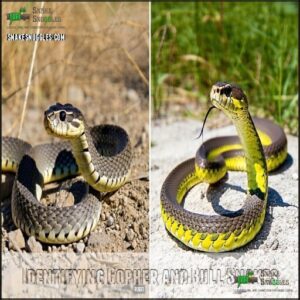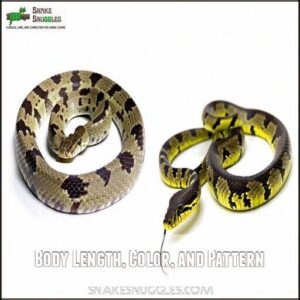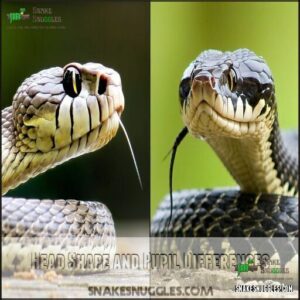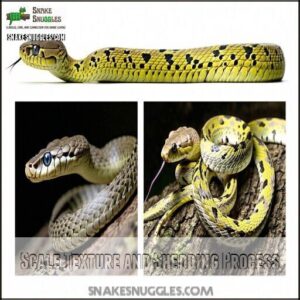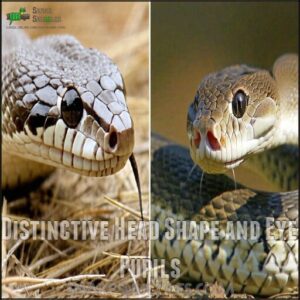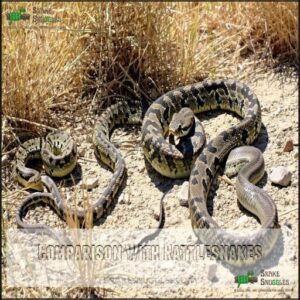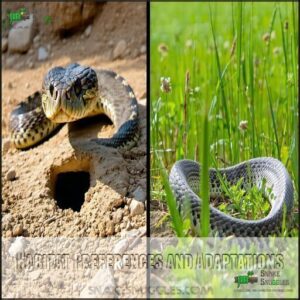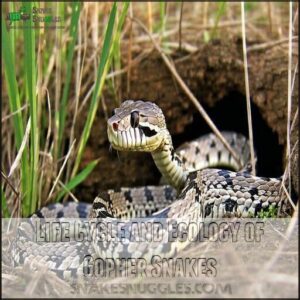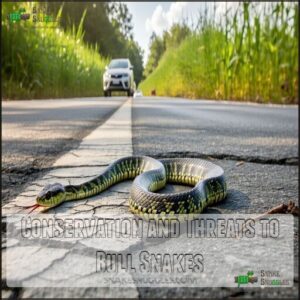This site is supported by our readers. We may earn a commission, at no cost to you, if you purchase through links.
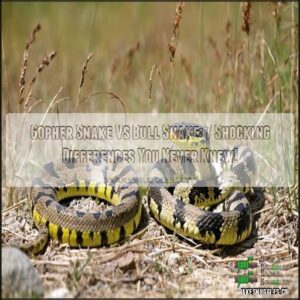
This case of mistaken identity happens because regional naming varies: western populations are typically called "gopher snakes" while midwestern specimens earn the "bull snake" moniker.
They’re constrictors reaching 4-7 feet long with similar yellowish-brown bodies featuring dark blotches. When threatened, they’ll hiss loudly, flatten their heads, and vibrate their tails—a remarkable rattlesnake impression that’s saved countless snake lives but confused many hikers.
Their rodent-hunting talents make them valuable allies in pest control.
Table Of Contents
- Key Takeaways
- Identifying Gopher and Bull Snakes
- Physical Characteristics of Gopher Snakes
- Distinguishing Features of Bull Snakes
- Life Cycle and Ecology of Gopher Snakes
- Conservation and Threats to Bull Snakes
- Frequently Asked Questions (FAQs)
- What is the Difference in Size Between Bull Snakes and Gopher Snakes?
- What is the Typical Diet of Bull Snakes and Gopher Snakes?
- How Do Bull Snakes and Gopher Snakes Defend Themselves?
- What Are the Geographical Ranges of Bull Snakes and Gopher Snakes?
- What is the difference between a gopher snake and a bull snake?
- How do you identify a bull snake?
- How poisonous is a gopher snake?
- Is it good to have gopher snakes in your yard?
- What is the difference between a bull snake and a gopher snake?
- What are the scientific names for bull snakes and gopher snakes?
- Conclusion
Key Takeaways
- You’re looking at the same species when comparing gopher snakes and bull snakes—they’re both Pituophis catenifer, with regional naming differences (western populations called "gopher snakes" and midwestern specimens known as "bull snakes").
- You’ll notice slight physical differences between the subspecies—bull snakes typically grow larger (6-8 feet) with brighter yellowish coloration, while gopher snakes are smaller (4-6 feet) with more muted tones.
- You can identify these beneficial predators by their distinctive defensive behavior: they’ll mimic rattlesnakes by flattening their heads, hissing loudly, and vibrating their tails against dry vegetation when threatened—despite being completely harmless and non-venomous.
- You’ll benefit from having these snakes around as they’re excellent natural pest controllers, with a single adult capable of eliminating up to 100 rodents annually from your property.
Identifying Gopher and Bull Snakes
You’ll discover that distinguishing between Pituophis catenifer subspecies isn’t as tricky as you might think, with bull snakes displaying brighter yellowish-brown coloration and blunt snouts compared to gopher snakes’ more muted tones.
When you’re out in the field, remember that bull snakes primarily inhabit the central United States while their gopher snake relatives dominate western regions, making geographic location a key identifier in your reptile observations.
Geographic Range and Distribution
Spotting these serpents in the wild requires understanding their geographic ranges. You’ll find distinct distribution patterns between these lookalike species.
- Gopher snakes dominate western territories, spreading from southwestern Canada through the Pacific states to northern Mexico
- Bull snakes primarily inhabit central regions, flourishing across the Great Plains and Midwestern states
- Their ranges create a natural overlap zone in central states where both species might be encountered
- While both prefer open country, gopher snakes adapt to higher elevations (up to 2,740 meters) compared to bull snakes (typically below 7,000 feet)
This habitat variation explains their subtle adaptive differences. You can find products related to the gopher snake’s habitat.
Physical Characteristics and Patterns
While exploring snake habitats across North America, you’ll want to know exactly what you’re looking at when you spot these fascinating reptiles.
Both are beneficial for natural rodent control in their respective ecosystems.
| Feature | Gopher Snake | Bull Snake |
|---|---|---|
| Body Size | 4-6 feet, slender | 6-8 feet, robust |
| Head Shape | Narrow, rounded | Wider with taller rostral scale |
| Coloration differences | Smooth tan scales with chain-like blotches | Stockier with yellowish-brown or reddish tones |
The snake identification process becomes easier once you understand these distinct scale patterns, snout shape, and pattern variation between gopher snake vs bull snake populations.
Behavior and Habitat Differences
While they may look similar, gopher snakes and bull snakes behave quite differently in their natural habitats.
Gopher snakes prefer rocky areas and open grasslands, establishing their snake habitat in coastal regions from British Columbia to Central Mexico.
In contrast, bull snakes thrive in sandy soil throughout North America, showing remarkable burrowing habits and climbing abilities.
Their daily activity follows diurnal patterns, but their social interactions differ dramatically—bull snakes are more defensive, often hissing and striking when handled, while gopher snakes typically display a more docile temperament when encountering humans.
Proper care involves understanding gopher snake enclosures to guarantee their well-being.
Defensive Mechanisms and Reactions
While both snakes typically avoid confrontation, their defensive mechanisms activate when they feel threatened.
These peaceful creatures have evolved remarkable ways to protect themselves without causing harm.
When cornered, gopher and bull snakes employ impressive defensive posturing to deter predators:
- Bull snakes excel at rattlesnake mimicry by producing loud hissing sounds, inflating their bodies, and vibrating their tails against dry leaves—sometimes releasing a musky odor as an additional deterrent.
- Gopher snakes often flatten their heads to appear more threatening, rely on bluff strikes, and may discharge a fecal spray when extremely frightened.
You’ll rarely witness these behaviors unless the snake feels truly trapped.
Physical Characteristics of Gopher Snakes
You’ll notice Pituophis catenifer, commonly known as the gopher snake, displays distinctive physical features including a slender body with creamy bellies and chain-like brown or black blotches on its beige or yellowish skin.
Its narrow, rounded head and tapering body are key identifiers that you can use to distinguish it from similar species like the brighter-colored bull snake, which shares the same scientific genus but exhibits different coloration patterns.
Body Length, Color, and Pattern
One of the most reliable ways to distinguish a gopher snake from its cousin is by examining its physical features.
Gopher snakes typically reach 4-6 feet in length, displaying slender proportions compared to the bulkier bull snakes.
Their coloration features chain-like patterns of dark blotches against lighter backgrounds.
Color variations exist regionally, with western specimens showing more yellowish hues while eastern populations tend toward grayish tones.
| Feature | Gopher Snake | Bull Snake |
|---|---|---|
| Length | 4-6 feet | 6-8 feet |
| Base Color | Tan to gray | Yellow to cream |
| Pattern | Chain-like blotches | Distinct saddle patterns |
| Markings | Eye-to-jaw stripe | Pronounced head bands |
| Scale texture | Smoother | More keeled |
The key differences between gopher snakes and bull snakes can be summarized by their physical characteristics and regional color variations.
By understanding these distinctions, one can more accurately identify a gopher snake in the wild.
Head Shape and Pupil Differences
The distinct head morphology between gopher and bull snakes provides essential clues for accurate snake identification in the wild.
When you’re trying to distinguish these snake lookalikes, focus on these key differences:
- Gopher snakes possess a more rounded head with a slight jaw-base swelling and large eyes with round pupils.
- Bull snakes feature a triangular-shaped head with eyes positioned on the sides, also with circular pupils.
- Both species have a protruding scale at the snout tip, though bull snakes’ rostral scales are typically more pronounced.
You’ll notice gopher snakes can inflate their heads into a diamond shape when threatened—a defensive mechanism that mimics venomous species. They’re known for defensive mimicry tactics to deter potential predators.
Despite their similar cranial structure, examining the scale patterns around the head reveals gopher snakes typically have fewer upper labial scales than bull snakes, which is an important factor for accurate snake identification in the wild, and helps to understand the distinct head morphology and defensive mimicry tactics of these species.
Scale Texture and Shedding Process
Beyond examining head shape, you’ll find the scale texture of gopher snakes provides another clear identifier in distinguishing them from bull snakes. Gopher snakes feature smooth, glossy scales with a polished feel when touched, while their scale patterns form distinctive chain-like blotches across their bodies.
During the ecdysis process (scientific term for shedding), gopher snakes display predictable phases:
- Skin dulls and eyes turn bluish as fluid separates old and new layers
- Increased rubbing against rough surfaces to initiate splitting
- Complete shed ideally comes off in one continuous piece
- Post-shedding reveals vibrant new scale composition
Shedding frequency varies by age, with younger snakes shedding every 4-6 weeks during growth spurts, while adults typically shed 2-4 times annually, which is a notable difference in their shedding frequency and overall scale composition.
Distinguishing Features of Bull Snakes
You’ll notice bull snakes have a distinctly blunt snout for burrowing and a brighter yellowish-brown coloration compared to their gopher snake relatives.
These larger constrictors (typically 6-8 feet long) lack rattles on their tails but can still create a convincing rattlesnake impression when threatened, using their size and behavior to mimic a threatened pose.
Lack of Rattle on Tail
Unlike their venomous cousins, bull snakes and gopher snakes lack an actual rattle but employ impressive tail morphology tricks for predator evasion. When threatened, these clever reptiles rapidly vibrate their tails against dry vegetation, creating a convincing rattlesnake-like sound—a perfect example of defensive mimicry in action.
This vibration communication isn’t just noise—it’s an evolutionary significance that helps both species survive. When you’re identifying gopher snake vs bull snake specimens, this defensive behavior provides valuable clues.
Distinctive Head Shape and Eye Pupils
When examining bull snakes up close, their head shape offers valuable identification clues that distinguish them from gopher snakes.
The bull snake’s head morphology features a more pronounced, angular rostral scale compared to the gopher snake’s smoother profile.
For reliable snake identification between these species, focus on:
- Pupil shape: Bull snakes display perfectly round pupils, while gopher snakes share this trait (unlike venomous pit vipers with vertical pupils)
- Eye placement: Bull snakes’ eyes sit slightly higher on the head
- Scale patterns: Bull snakes have more pronounced keeled scales near the head.
The snout differences are particularly telling—bull snakes possess a more pointed snout adapted for burrowing, making gopher snake vs bull snake comparison straightforward once you know these features.
These scales also aid in snake locomotion methods.
Comparison With Rattlesnakes
While their pointed heads differ from rattlesnakes’ triangular shape, bull and gopher snakes have perfected rattlesnake mimicry as a clever survival tactic.
When threatened, these harmless constrictors flatten their heads and vibrate their pointed tails against dry vegetation, creating a convincing rattling sound without actual rattles.
You’ll notice key differences that help with identification: bull and gopher snakes have round pupils (not vertical slits), lack facial heat-sensing pits, and have more slender bodies extending 6-9 feet—considerably longer than the stockier 3-6 foot rattlesnakes.
This defensive mimicry helps these beneficial rodent-controllers survive in regions where habitat overlap occurs, despite having zero venom and dramatically lower bite severity.
Habitat Preferences and Adaptations
Bull snakes thrive in four distinct habitat zones across North America, showcasing remarkable climate tolerance from arid deserts to prairie grasslands.
Bull snakes flourish across diverse North American territories, mastering survival from scorching deserts to windswept prairies with remarkable adaptability.
These adaptable reptiles have developed specialized burrowing adaptations that distinguish them from their gopher snake cousins:
- Creating extensive tunnel networks in loose soil for temperature regulation and predator avoidance
- Establishing strategic dens near high prey abundance areas, maximizing hunting efficiency
- Utilizing abandoned rodent burrows to conserve energy during harsh weather conditions
While gopher snake range dominates western territories, bull snake distribution centers through the Great Plains region. You’ll notice habitat overlap in boundary zones, where both species display subtle differences in their preferred snake habitat and foraging behaviors.
Life Cycle and Ecology of Gopher Snakes
You’ll be amazed at how gopher snakes adapt to their environment throughout their 12-20 year lifespan, from spring mating rituals to winter hibernation in communal dens.
As diurnal hunters, they’ll efficiently control rodent populations in your area while completing their annual cycle of reproduction, growth, and dormancy.
Diet and Foraging Habits
Moving from defensive behaviors to dining preferences, let’s explore how these serpents satisfy their appetites.
Both gopher and bull snakes have developed specialized foraging habits that position them as key players in the food chain. Their typical diet consists primarily of rodents, making them natural pest controllers in their ecosystems.
Their foraging habits change with seasons – they’re voracious eaters during warm months but slow down in winter. Understanding their needs requires insight into gopher snake feeding.
You’ll notice the following characteristics of their diets:
Their digestive system efficiently processes prey whole, sometimes taking days to complete digestion. Juveniles start with smaller meals before graduating to the adult snake diet of larger rodents.
Reproduction and Nesting Process
After digesting their prey, gopher and bull snakes focus on creating the next generation.
Spring awakens their mating rituals, with males seeking receptive females through chemical tracking.
Snake reproduction follows a predictable pattern:
- Nest site selection occurs in late spring, with females favoring sandy soil or abandoned rodent burrows
- Egg-laying happens between June and August, with clutch sizes ranging from 3-24 eggs (healthier females produce larger clutches)
- Incubation period lasts 65-75 days, after which hatchlings emerge fully independent
You’ll notice these youngsters receive no parental care—they’re on their own from day one!
They’re known to use abandoned rodent homes for shelter.
Hibernation Patterns and Overwintering
While their reproductive season concludes, gopher and bull snakes prepare for winter survival through hibernation.
As temperatures fall below 15°C, these snakes experience significant metabolic rate reduction to conserve energy during cold months.
Their remarkable cold tolerance depends on proper den site selection, with four critical factors affecting their overwintering success:
- Burrow depth must reach below the frost line for adequate protection
- Regional variations influence hibernation duration – northern populations hibernate up to 7 months
- Snake behavior often includes communal denning where multiple snakes share heat
- Emergence timing correlates with soil temperature reaching 10°C consistently
Their climate tolerance and burrowing adaptations showcase remarkable evolutionary survival strategies.
Growth Rate and Lifespan Expectations
Four striking differences mark the growth patterns of these fascinating serpents.
Hatchling growth starts rapidly, with both species gaining approximately 30 cm in their first year before their growth rate gradually slows.
Adult size varies slightly—gopher snakes typically reach 3-7 feet (averaging 5 feet), while bull snakes grow marginally larger at 4-6 feet, occasionally stretching to 8 feet.
Sexual maturity arrives earlier for males (1.5-2 years) than females (3-4 years).
Wild longevity typically spans 12-15 years, but captivity lifespan can extend impressively to 30+ years with proper care.
Snake weight increases proportionally throughout their development, with females often outweighing males of equal length, and this is a key factor in their overall growth and development, with proper care being essential for their longevity.
Conservation and Threats to Bull Snakes
You’ll find bull snakes facing significant population decline due to habitat fragmentation and vehicular mortality across their North American range.
Their frequent misidentification as rattlesnakes has unfortunately led to intentional killing, despite their beneficial role in controlling rodent populations that would otherwise damage crops and spread disease, highlighting their importance in ecosystem balance.
Habitat Loss and Fragmentation
The ongoing battle against habitat fragmentation has pushed both bull snakes and gopher snakes to the brink of ecological disaster.
As human development expands, these beneficial reptiles face unprecedented challenges to their survival across North America, particularly in Alberta and Saskatchewan.
Wildlife biologists document five critical threats:
- Severed migration corridors isolate snake populations, reducing genetic diversity
- Protected areas become ecological islands surrounded by inhospitable development
- Den site destruction eliminates essential overwintering shelters
- Fragmented grasslands limit hunting territories and prey availability
- Ecosystem impact ripples through food webs as snake populations decline
Conservation strategies now focus on habitat connectivity, establishing wildlife corridors between remaining natural areas.
Without these efforts, snake habitat loss will continue unabated.
The situation is particularly dire in regions like B.C.’s Okanagan Valley, where less than 9% of native habitat remains undisturbed—leaving these remarkable constrictors with nowhere to call home, facing an unprecedented ecological disaster and unabated loss, in need of conservation strategies and wildlife corridors to ensure their survival and prevent further habitat loss.
Road Mortality and Collision Risks
The asphalt ribbon cutting through natural habitats creates deadly consequences for both gopher and bull snakes.
Road mortality remains one of the greatest threats to these beneficial predators, with traffic volume directly correlating to population impact.
| Risk Factor | Mitigation Strategy |
|---|---|
| Seasonal migration | Wildlife underpasses |
| Traffic volume | Speed reduction zones |
| Habitat fragmentation | Corridor connectivity |
| Basking behavior | Warning signage |
| Weather patterns | Temporary closures |
You’ll notice collision risks spike during spring and summer when these snakes actively search for mates and food.
Their natural instinct to thermoregulate on warm asphalt becomes a deadly attraction, especially at dusk.
Road mitigation efforts include installing specialized culverts and drift fencing to guide snakes safely under roadways.
Conservation biologists track collision hotspots to implement targeted protections where they’re most needed, preserving habitat connectivity for future generations, which is crucial for the survival of these beneficial predators and maintaining ecological balance.
This approach helps in reducing road mortality and promoting a healthier ecosystem.
By understanding the collision risks and implementing effective mitigation strategies, we can better protect these species.
Human Persecution and Misidentification
While roads pose a significant threat to snake populations, human persecution driven by fear remains equally devastating.
Bull and gopher snakes face a deadly case of mistaken identity when their defensive behaviors—like flattening their heads and vibrating their tails—lead people to confuse them with venomous rattlesnakes.
These harmless reptiles often pay the ultimate price for their convincing mimicry:
- Each unnecessary killing removes a natural pest controller from your local ecosystem
- A single adult bull snake can eliminate up to 100 rodents annually from your property
- Fear-based reactions often stem from snake misconceptions passed down through generations
- Your ability to identify nonvenomous snakes directly impacts conservation success
The conservation impact extends beyond individual snakes to affect entire ecosystems.
By learning basic snake identification skills, you’ll help protect these beneficial predators and overcome the fear factor that drives their persecution.
Conservation Efforts and Protection Measures
Across North America, bull snake conservation efforts focus on habitat preservation and legal protections.
In Canada, these snakes receive provincial Wildlife Act protection, with special safeguards for hibernation sites from September through April.
Conservation measures include population monitoring programs that track genetic diversity and abundance trends, and dedicated protection areas within national parks like Grasslands National Park, specifically designed to counter habitat destruction.
Public education campaigns help reduce human persecution by highlighting these snakes’ essential ecological role.
You can contribute by reporting sightings, respecting snake habitats, and supporting protection measures in your community to aid in conservation efforts.
Frequently Asked Questions (FAQs)
What is the Difference in Size Between Bull Snakes and Gopher Snakes?
Bull snakes are typically larger, reaching 6-8 feet in length with a more robust build.
You’ll notice gopher snakes are generally smaller and more slender, rarely exceeding 5 feet when fully grown.
What is the Typical Diet of Bull Snakes and Gopher Snakes?
Both these snakes primarily feast on rodents like mice and rats.
You’ll find they also enjoy birds, eggs, and lizards in their diet, making them excellent natural pest controllers in their habitats.
How Do Bull Snakes and Gopher Snakes Defend Themselves?
When threatened, both these snakes will puff up, flatten their heads, hiss loudly, and even mimic rattlesnakes by vibrating their tails. You’ll notice they’re masters of bluffing rather than striking.
What Are the Geographical Ranges of Bull Snakes and Gopher Snakes?
While you’d think they’re everywhere, they’re not.
You’ll find gopher snakes in western U.S. to northern Mexico, while bull snakes inhabit central U.S. and Canada.
Notably, bull snakes don’t live in Arizona.
What is the difference between a gopher snake and a bull snake?
Actually, they’re technically the same species.
Gopher snakes and bull snakes are both subspecies of Pituophis catenifer, though bull snakes are typically larger with brighter yellow coloration, while gopher snakes have more muted tones.
How do you identify a bull snake?
You’ll identify a bull snake by its bright yellowish-brown coloration, large size (6-8 feet), blunt snout for burrowing, and chain-like blotches on its body.
They’re mainly found in central U.S., Canada, and Mexico.
How poisonous is a gopher snake?
Gopher snakes aren’t poisonous at all.
They’re completely nonvenomous constrictors that kill prey by squeezing.
You’ve got nothing to fear from these beneficial reptiles that help control rodent populations around your property.
Is it good to have gopher snakes in your yard?
Yes, it’s absolutely beneficial to have gopher snakes in your yard.
They’re excellent natural pest controllers, keeping rodent populations in check.
You’ll appreciate their nonvenomous nature and how they help maintain your garden’s ecosystem balance.
What is the difference between a bull snake and a gopher snake?
Bull snakes and gopher snakes are actually the same species (Pituophis catenifer) but different subspecies.
You’ll notice bull snakes have brighter yellows with darker blotches, while gopher snakes display more muted, beige coloration, which helps to distinguish them as different subspecies.
What are the scientific names for bull snakes and gopher snakes?
Both snakes share the scientific name Pituophis catenifer, as they’re subspecies of the same species.
Bull snakes are Pituophis catenifer sayi, while gopher snakes include several subspecies like P. c. affinis and P. c. deserticola.
Conclusion
Whether you’ve encountered a gopher snake or bull snake, you’ve met the same fascinating reptile.
These remarkable constrictors, often misidentified due to regional naming traditions, serve as nature’s pest controllers with their impressive rodent-hunting skills.
Now that you understand the gopher snake vs bull snake confusion, you’ll appreciate their value in ecosystems across North America.
Remember, their rattlesnake impersonation is just that—a clever defense mechanism from a harmless, beneficial predator worthy of our protection.
- http://www.californiaherps.com/snakes/maps/xpcateniferspeciesmap3.jpg
- https://www.terminix.com/blog/science-nature/identify-types-of-gopher-snakes/
- https://en.wikipedia.org/wiki/Bullsnake
- https://reptilesmagazine.com/gopher-snake-care-and-breeding-information/?srsltid=AfmBOooiruGnczjKsCpTC_uJLe01VNfSpaG09J-jbae84fvL43Kbpnb1
- https://californiaherps.com/snakes/pages/p.c.affinis.html

